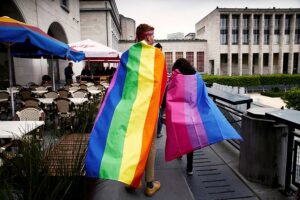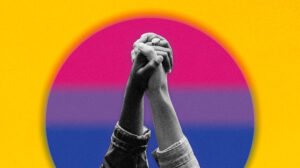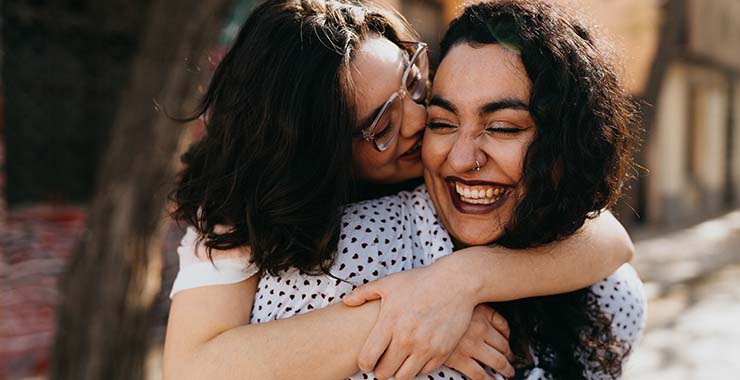Bisexuality and lesbianism are two important aspects of human sexuality that have been widely discussed and explored in recent years. With increasing awareness and acceptance, it is crucial to understand these identities, their similarities, and their differences. In this article, we will delve into the meanings, experiences, and challenges faced by individuals who identify as bisexual or lesbian. By examining their unique journeys, we can gain a deeper understanding of their lives, relationships, and contributions to society.
Contents
Understanding Bisexuality

Bisexuality is a sexual orientation characterized by the potential for romantic or sexual attraction to people of both the same gender (homosexuality) and different gender (heterosexuality). Individuals who identify as bisexual are commonly referred to as bisexual people or simply “bisexuals.”
Here are some key points to help understand bisexuality:
- Attraction to Multiple Genders: Bisexual individuals can experience a range of attractions, including emotional, romantic, and sexual attraction, towards both men and women or more broadly, to individuals of multiple genders, including non-binary and genderqueer people.
- Not Limited to Two Genders: Despite the “bi” prefix in bisexuality, it’s essential to understand that bisexuality is not limited to just two genders (male and female). The term encompasses attraction to more than one gender.
- Diverse Experiences: Bisexual individuals have diverse experiences and identities. Some may experience equal attraction to all genders, while others might have varying degrees of attraction to different genders.
- Myths and Misconceptions: Bisexuality has been subject to various myths and misconceptions. One common misconception is that bisexuality is a transitional phase or that bisexual individuals are inherently promiscuous.
Understanding Lesbianism
Lesbianism refers to the sexual orientation and romantic attraction between women. A woman who identifies as a lesbian is romantically, emotionally, and/or sexually attracted exclusively or predominantly to other women. Here are some key points to help understand lesbianism:
- Same-Sex Attraction: Lesbianism involves same-sex attraction, where women experience feelings of love, desire, and intimacy primarily toward other women.
- Diverse Experiences: Lesbian individuals have diverse experiences, identities, and expressions. Some may have known about their sexual orientation from a young age, while others may come to understand their attraction to women later in life.
- Not a Choice: Sexual orientation, including lesbianism, is not a choice but rather an inherent aspect of a person’s identity. It is important to respect and support individuals in understanding and embracing their sexual orientation.
- Challenges and Acceptance: Lesbian individuals, like other members of the LGBTQ+ community, may face challenges related to societal attitudes, discrimination, and legal issues. Acceptance and support from family, friends, and society at large can significantly impact the well-being of lesbian individuals.
Similarities and Differences
These are some of the factors that depict similarities and differences:
Similarities
- Sexual Orientation: Both bisexuality and lesbianism are sexual orientations. They both describe a person’s primary romantic and/or sexual attraction towards specific genders or gender identities.
- Same-Sex Attraction: Both bisexuality and lesbianism involve same-sex attraction in some form. In bisexuality, individuals are attracted to both the same gender and different genders, while in lesbianism, women are attracted exclusively or predominantly to other women.
- LGBTQ+ Identities: Both bisexuality and lesbianism are part of the LGBTQ+ spectrum, which encompasses diverse sexual orientations and gender identities.
- Challenges: Both bisexual and lesbian individuals may face challenges related to societal attitudes, discrimination, and acceptance. They may encounter similar struggles in coming out, finding acceptance, and dealing with biphobia and homophobia.
- Representation and Visibility: Both bisexual and lesbian communities advocate for representation and visibility in various aspects of society to foster understanding and reduce stigma.
Differences
- Gender Attraction: The primary difference lies in the gender(s) to which individuals are attracted. Bisexual individuals experience attraction to more than one gender, which can include men, women, non-binary, and other gender identities. Lesbian individuals, on the other hand, exclusively or predominantly experience romantic and/or sexual attraction to other women.
- Bisexual Identity: Bisexuality encompasses a broader range of attraction, whereas lesbianism is specific to women’s same-sex attraction. Bisexual individuals may experience different degrees of attraction to different genders, while lesbian individuals are primarily attracted to women.
- Inclusive Terminology: The term “lesbian” specifically refers to women who are attracted to women, which means it is a more gender-specific label. Bisexuality, on the other hand, is a more inclusive term as it encompasses attraction to multiple genders.
- Visibility and Awareness: Historically, lesbianism has been more visible and acknowledged in society compared to bisexuality. Bisexuality has often faced erasure and misconceptions, making awareness and understanding critical for bisexual individuals.

Navigating relationships and community is an essential aspect of life for everyone, regardless of their sexual orientation. Here are some general tips that can be applied to help you navigate relationships and community in a positive and fulfilling way:
- Self-Awareness: Understand yourself, your needs, and your values. Being self-aware will help you make conscious choices in relationships and communities that align with who you are.
- Communication: Effective communication is the foundation of any healthy relationship. Be open, honest, and willing to listen to others. Express your thoughts and feelings respectfully.
- Respect and Empathy: Show respect and empathy towards others. Be mindful of their feelings, experiences, and perspectives. Empathy fosters understanding and strengthens connections.
- Set Boundaries: Establish healthy boundaries to protect your emotional well-being. Communicate your boundaries clearly to others, and respect theirs as well.
- Seek Supportive Relationships: Surround yourself with people who support and uplift you. Seek out friends and partners who appreciate you for who you are and respect your sexual orientation.
- LGBTQ+ Community Involvement: Engage with the LGBTQ+ community to find a sense of belonging and solidarity. Attend community events, join support groups, or participate in advocacy efforts.
- Educate and Advocate: Educate others about LGBTQ+ issues and advocate for inclusivity and acceptance. By sharing your experiences, you can help dispel myths and misconceptions.
Health and Well-being
Health and well-being are essential aspects of life that encompass physical, mental, emotional, and social aspects. Here are some tips to promote overall health and well-being:
Physical Health
- Regular Exercise: Engage in regular physical activity, such as walking, jogging, cycling, or any form of exercise you enjoy. Aim for at least 150 minutes of moderate-intensity exercise per week.
- Balanced Diet: Maintain a balanced diet rich in fruits, vegetables, whole grains, lean proteins, and healthy fats. Stay hydrated by drinking an adequate amount of water daily.
- Adequate Sleep: Prioritize getting enough restful sleep each night, as it is crucial for physical and mental well-being.
- Routine Health Check-ups: Schedule regular health check-ups with your healthcare provider to monitor your health and catch any potential issues early on.
Mental and Emotional Health
- Stress Management: Find healthy ways to cope with stress, such as practicing mindfulness, meditation, deep breathing exercises, or engaging in hobbies that bring you joy.
- Seek Support: Reach out to friends, family, or a mental health professional if you need someone to talk to or support for any emotional challenges you may be facing.
- Limit Negative Influences: Be mindful of negative influences, such as excessive exposure to news or social media that can impact your mental well-being. Set healthy boundaries and take breaks when needed.
- Practice Self-Compassion: Be kind to yourself and practice self-compassion. Treat yourself with the same kindness and understanding you would offer to a friend.
Social Well-being
- Build Supportive Relationships: Nurture positive relationships with family and friends. Surround yourself with people who uplift and support you.
- Connect with Community: Engage with your community, including the LGBTQ+ community, to foster a sense of belonging and support.
- Volunteer or Help Others: Giving back and helping others can boost your well-being and provide a sense of purpose.
Bisexuality and Lesbianism in Society

Bisexuality and lesbianism have significant impacts on society, influencing various aspects of culture, politics, and social attitudes. Here are some ways in which bisexuality and lesbianism manifest in society:
- Visibility and Representation: As more individuals come out as bisexual or lesbian, there has been increased visibility of these sexual orientations in society. Representation in media, literature, and public figures helps challenge stereotypes and misconceptions.
- LGBTQ+ Advocacy: Bisexual and lesbian individuals are active participants in LGBTQ+ advocacy and activism. They join forces with other members of the community to fight for equal rights, anti-discrimination laws, and improved healthcare access.
- Intersectionality: Bisexual and lesbian individuals, like all members of the LGBTQ+ community, have intersecting identities. Issues related to race, ethnicity, gender, disability, and socioeconomic status can influence their experiences, highlighting the importance of addressing intersectionality within the community.
Conclusion
Understanding bisexuality and lesbianism is crucial for fostering empathy, acceptance, and inclusivity in society. These identities contribute to the diverse tapestry of human experiences, and their visibility helps challenge outdated norms. By embracing the unique journeys of bisexual and lesbian individuals, we can create a more equitable world where everyone can live authentically and without fear of discrimination.
Life may sometimes be challenging if you are a lesbian, but Online Lesbian Counseling can help. Get experienced LGBTQ therapists at PrideMantra: Book a trial LGBTQ therapy session.


